Useful tips for a pandemic exit plan. Gimbe Report
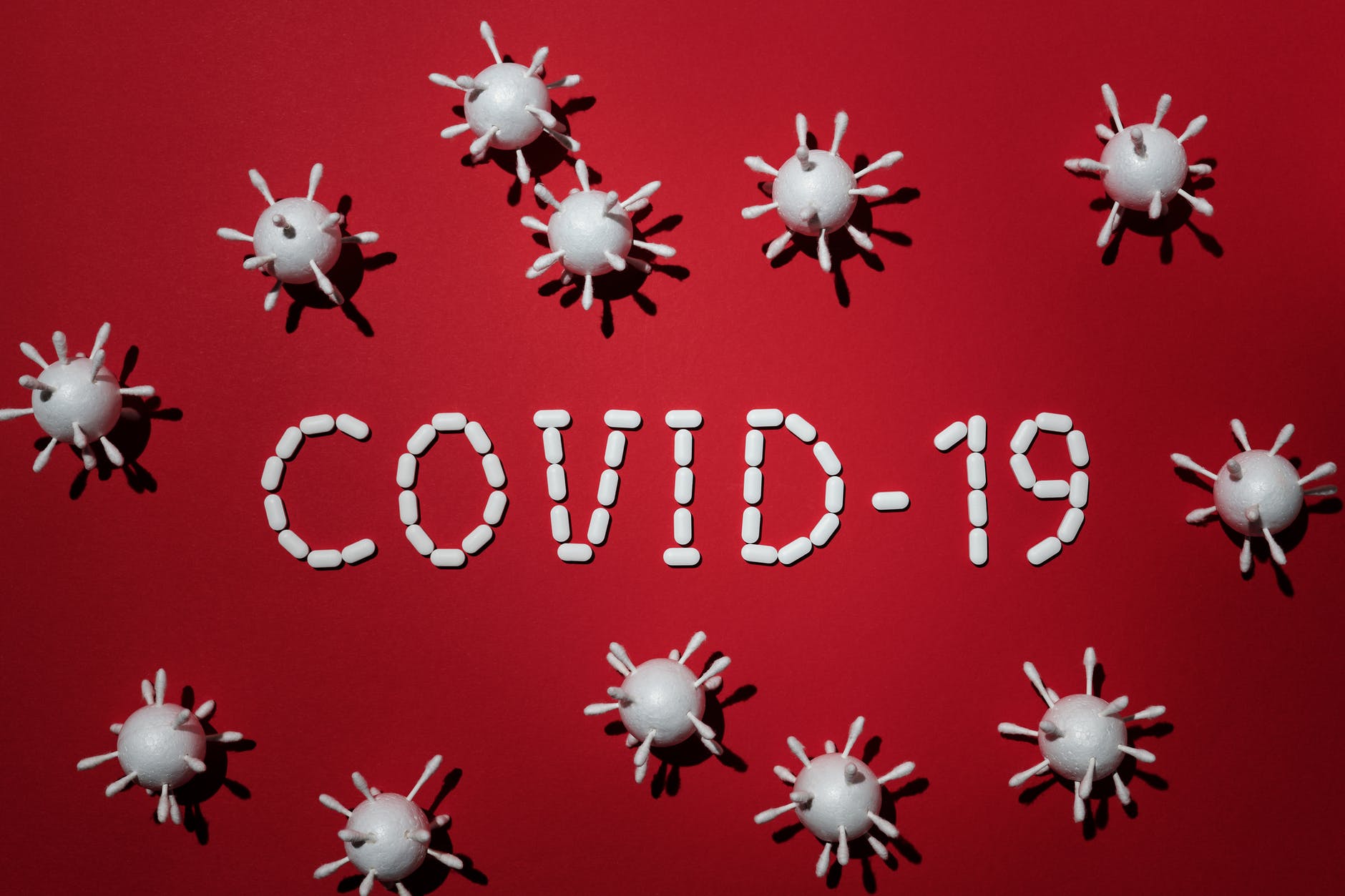
Gimbe report on pandemic progress, vaccination campaign status and pandemic exit plan
Standardize the rules on interregional mobility with those for travel abroad, both to limit return infections and not to damage national tourism.
It is one of the points recommended by the Gimbe Foundation as part of a pandemic exit plan.
Assuming that the effects of the restrictive measures ordered from March will be seen at least until mid-May and that the gradual return to yellow will determine a rise in infections, we need to review the system of "color" Regions: "new parameters are needed to promptly implement local closures and avoiding the spread of contagion ”, reads the report of the Gimbe foundation chaired by Nino Cartabellotta.
Not only that: it is necessary to intervene with adequate investments, as has not yet been done, to enhance the tracing and sequencing, the adaptation of schools and transport, to standardize the rules on inter-regional mobility with those for travel abroad, to encourage the smart work and intensify controls, gradually loosened after the first lockdown.
Here are all the details of the Gimbe report on pandemic progress, vaccination campaign status and pandemic exit plan:
The independent monitoring of the Gimbe Foundation detects in the week 14-20 April 2021, compared to the previous one, a decrease in new cases (90,030 vs 106,326) (figure 1) and deaths (2,545 vs 3,083) (figure 2). Currently positive cases are also decreasing (482.715 vs 519.220), people in home isolation (456.309 vs 488.742), hospitalizations with symptoms (23.255 vs 26.952) and intensive care (3.151 vs 3.526) (figure 3). In detail, compared to the previous week, the following changes were recorded:
- Deaths: 2,545 (-17.5%)
Intensive care: -375 (-10.6%)
Hospitalized with symptoms: -3,697 (-13.7%)
Home isolation: -32,433 (-6.6%)
New cases: 98,030 (-7.8%)
Currently positive cases: -36,505 (-7%)
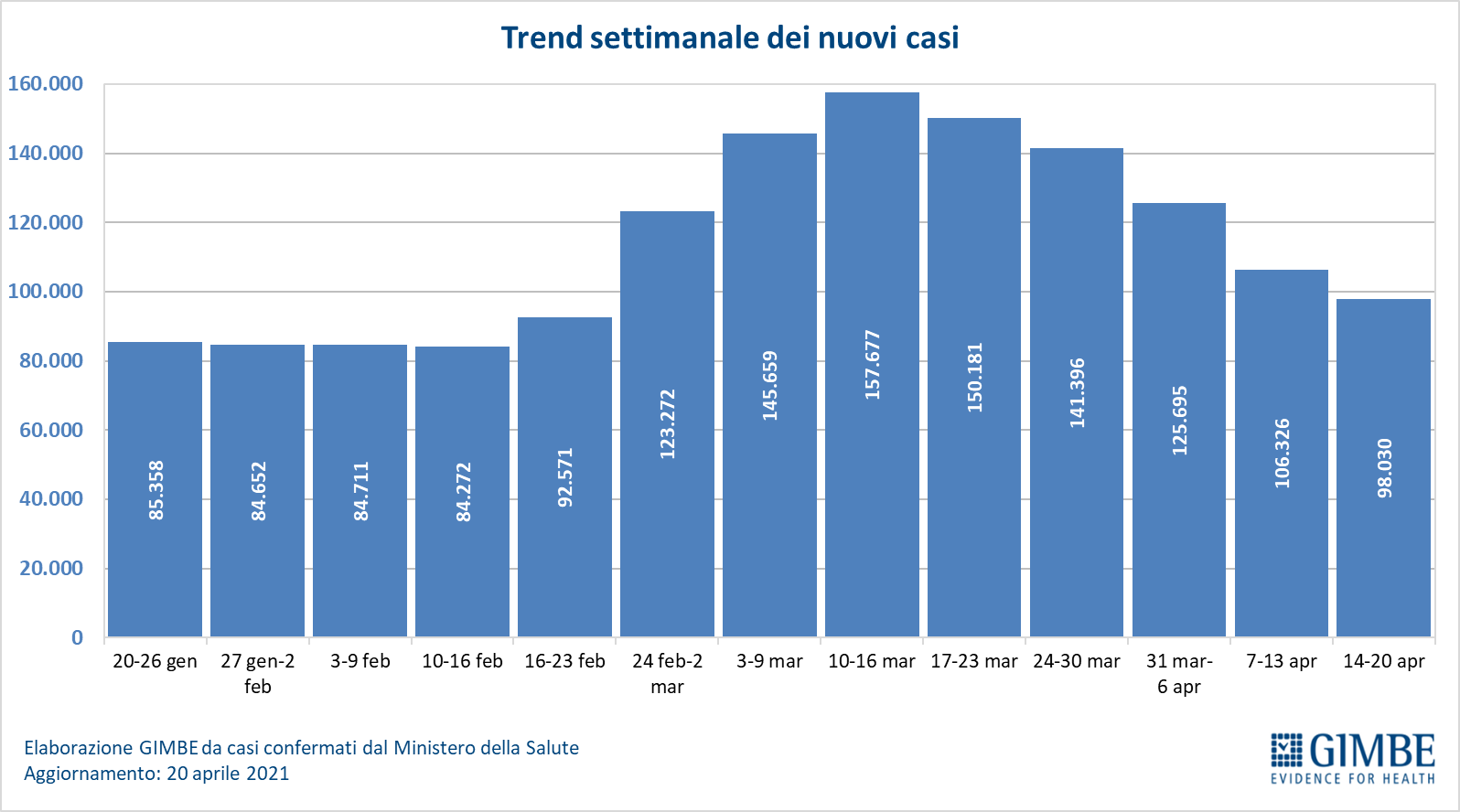
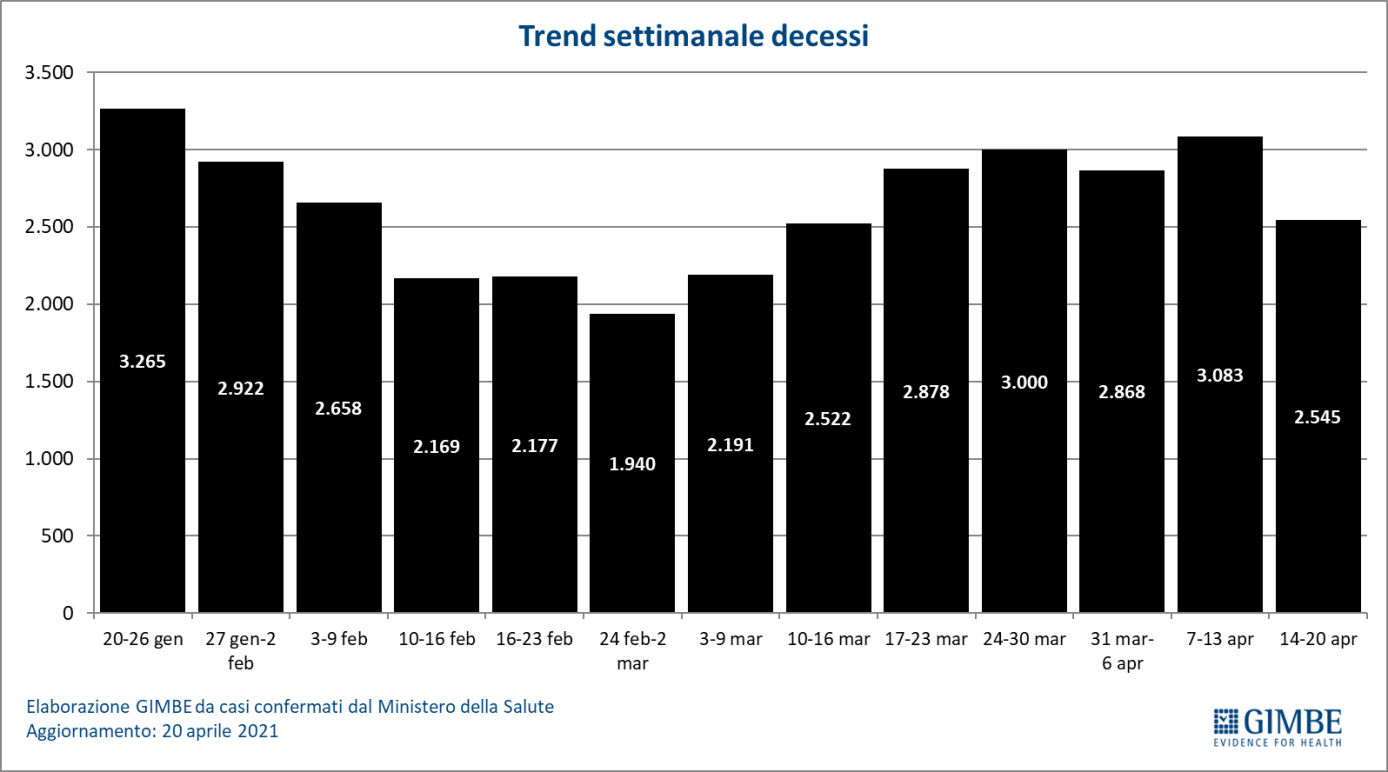
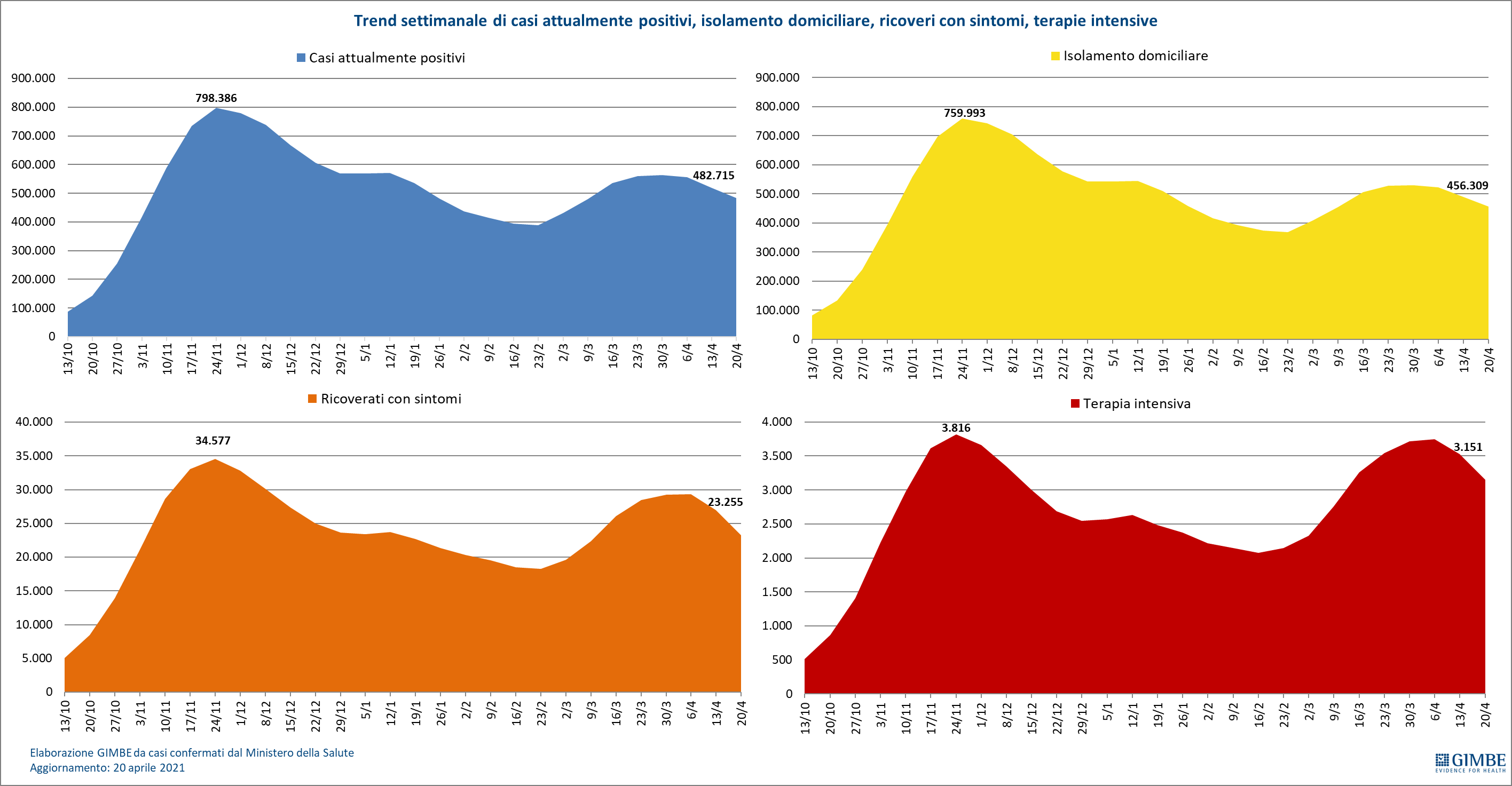
«The circulation of the virus in our country – declares Nino Cartabellotta, President of the Gimbe Foundation – is still sustained. With the progressive reduction of new weekly cases, the currently positive cases, reached the peak of the third wave on 5 April (570,096), fell to 482,000, a very high number and underestimated by the insufficient testing & tracing activity ». Moreover, the national data is affected by heterogeneous regional situations: in fact, the percentage variation of new cases increases in 3 Regions and currently positive cases are growing in 6 Regions (table).
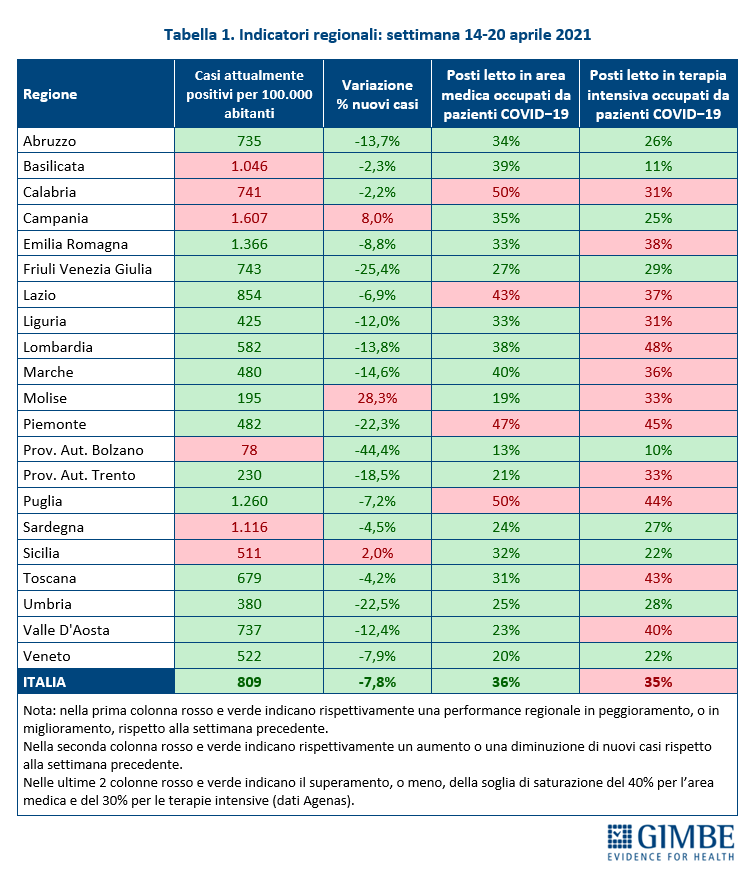
"The pressure on hospitals is also gradually easing – says Renata Gili, Head of Research on Health Services of the Gimbe Foundation – but the number of beds occupied, both in the medical area and in intensive care, is still high in many regions". In detail:
- Medical area: the curve peaked on 6 April (no. 29,337) and began its descent with a reduction of 20.7% in 14 days; however the absolute numbers remain high (23,255) and the employment by COVID patients exceeds 40% in 4 Regions.
- Intensive care: the curve peaked on April 6 (No. 3,743), but the descent is slower, with a reduction of 15.8% in 14 days; 3,151 beds remain occupied and in 12 Regions the saturation threshold exceeds 30% (Figure 4). "Numbers still high even for new daily admissions to intensive care – explains Marco Mosti, Operational Director of the GIMBE Foundation – with a 7-day moving average of 182 admissions / day, albeit decreasing for a month" (figure 5).
- Vaccines: supplies. As of April 21 (update at 7.38 am) 17,752,110 doses were delivered, 25.9% of those scheduled for the 1st half of 2021. In detail:
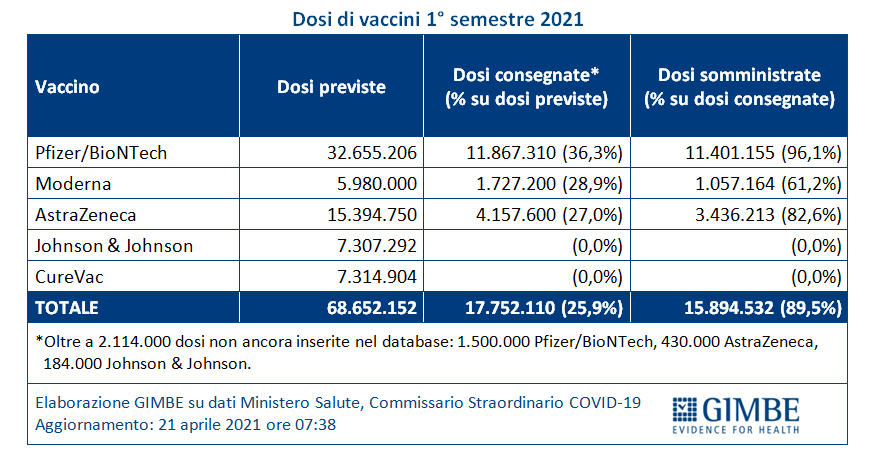
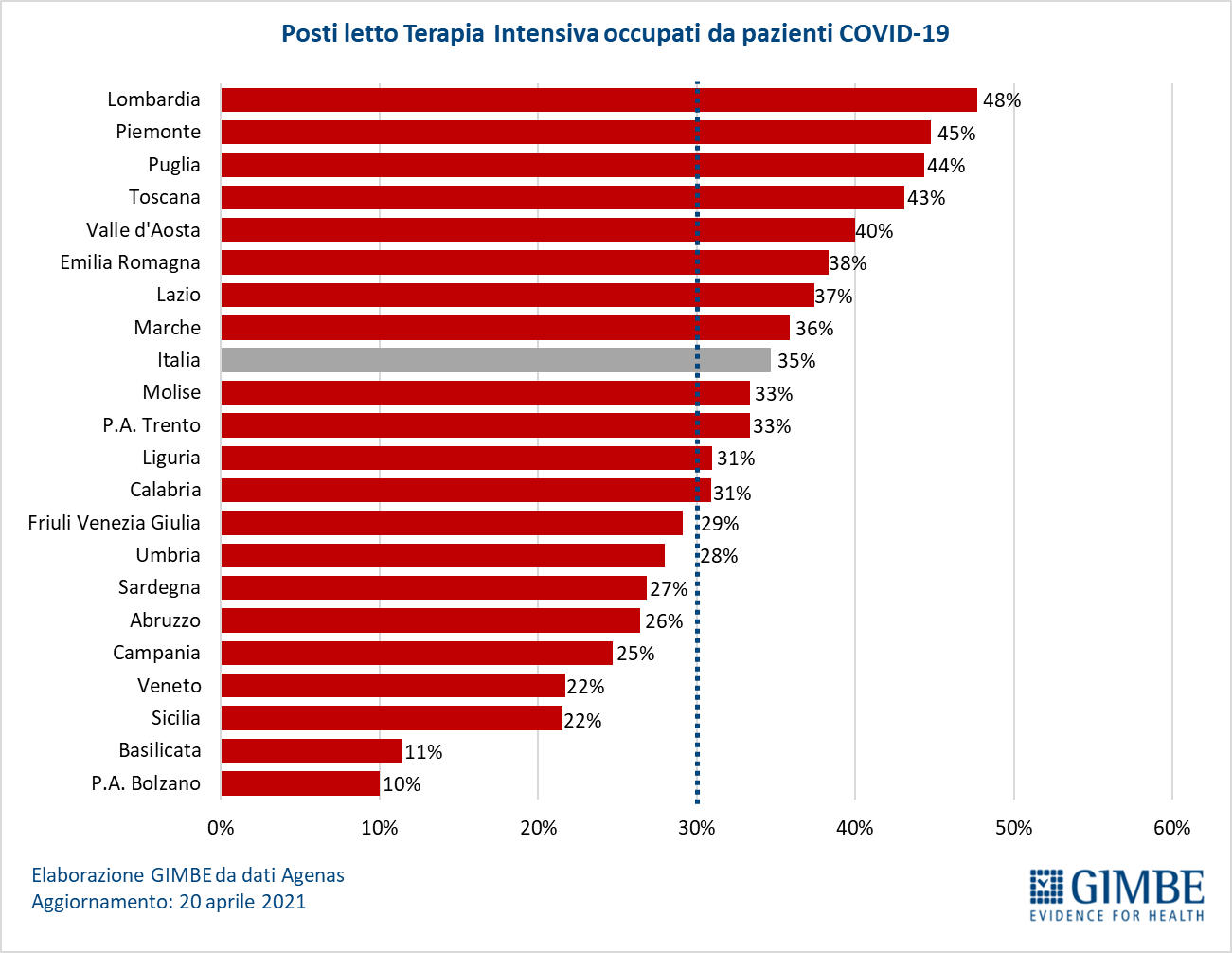
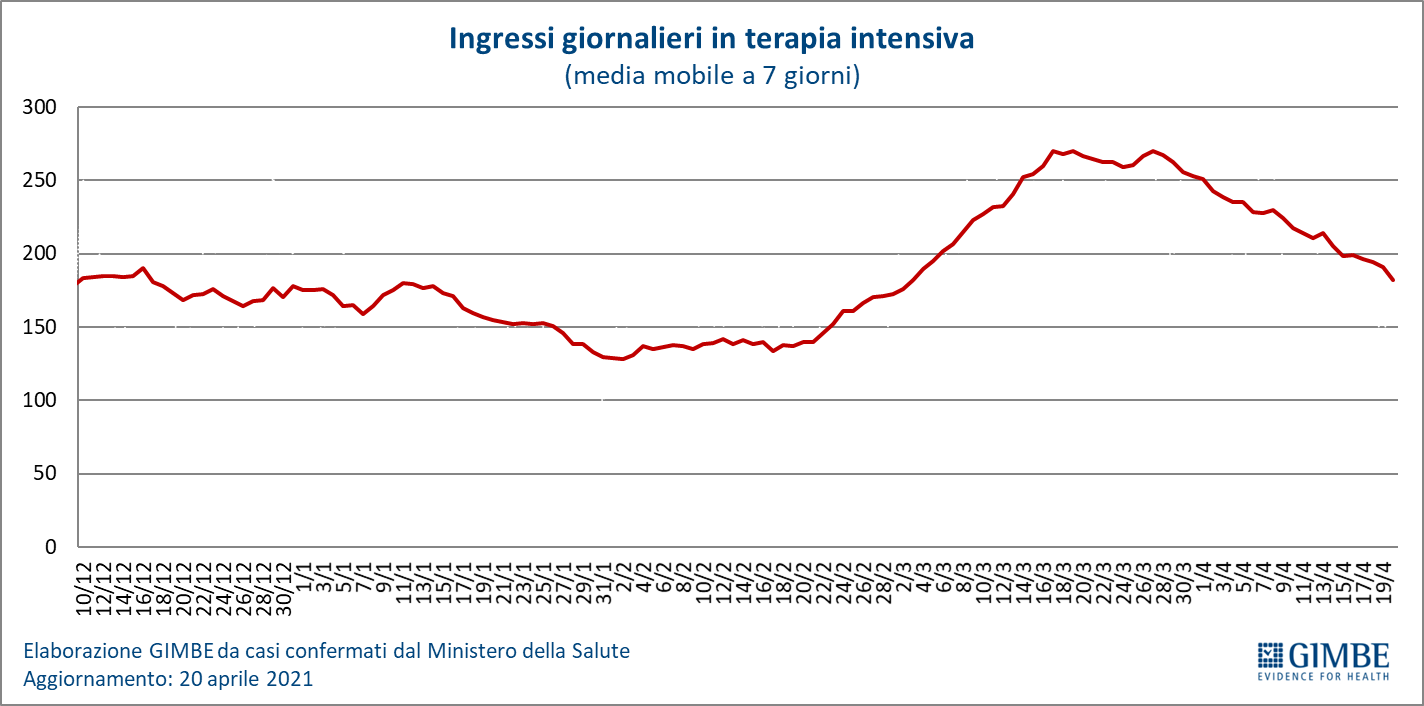
"In the last two weeks – states Cartabellotta – about 5.7 million doses have been delivered: numbers growing, but still far from guaranteeing the 3.5 million weekly doses of the Piano Figliuolo".
Vaccines: administrations.
As of April 21 (update at 7.38 am) 18.8% of the population received at least one dose of vaccine (No. 11.240.182) and 7.8% completed the vaccination cycle with the second dose (No. 4.654.357 ), with significant regional differences (Figure 6). Despite the 35.5% increase in inoculated doses in the last three weeks (figure 7), as of April 20 the 7-day moving average of the administrations remains at 315,506 per day: over 180,000 fewer than the 500,000 envisaged by the Plan by mid-April (figure 8). With respect to the coverage of the priority categories defined in the Ordinance of 9 April by the Extraordinary Commissioner, in the face of significant regional differences, the analysis of the national data reveals:
- Over 80: of the over 4.4 million, 2,282,611 (51.6%) completed the vaccination course and 1,336,007 (30.2%) received only the first dose (Figure 9).
- Fragile subjects and their caregivers: from 20 April a specific reporting category has been added to the official database, which reports 1,847,928 doses administered. "However – specifies Gili – it is not possible to carry out further analyzes because the following are not available: the subdivision between 1st and 2nd dose, the total number of frail subjects and their caregivers and their regional distribution".
- Age range 70-79: of the over 5.9 million, 284,113 (4.8%) completed the vaccination course and 2,133,528 (35.7%) received the first dose only (Figure 10).
- Age range 60-69: of the over 7.3 million, 438,890 (6%) completed the vaccination course and 965,448 (13.1%) received the first dose only (Figure 11).
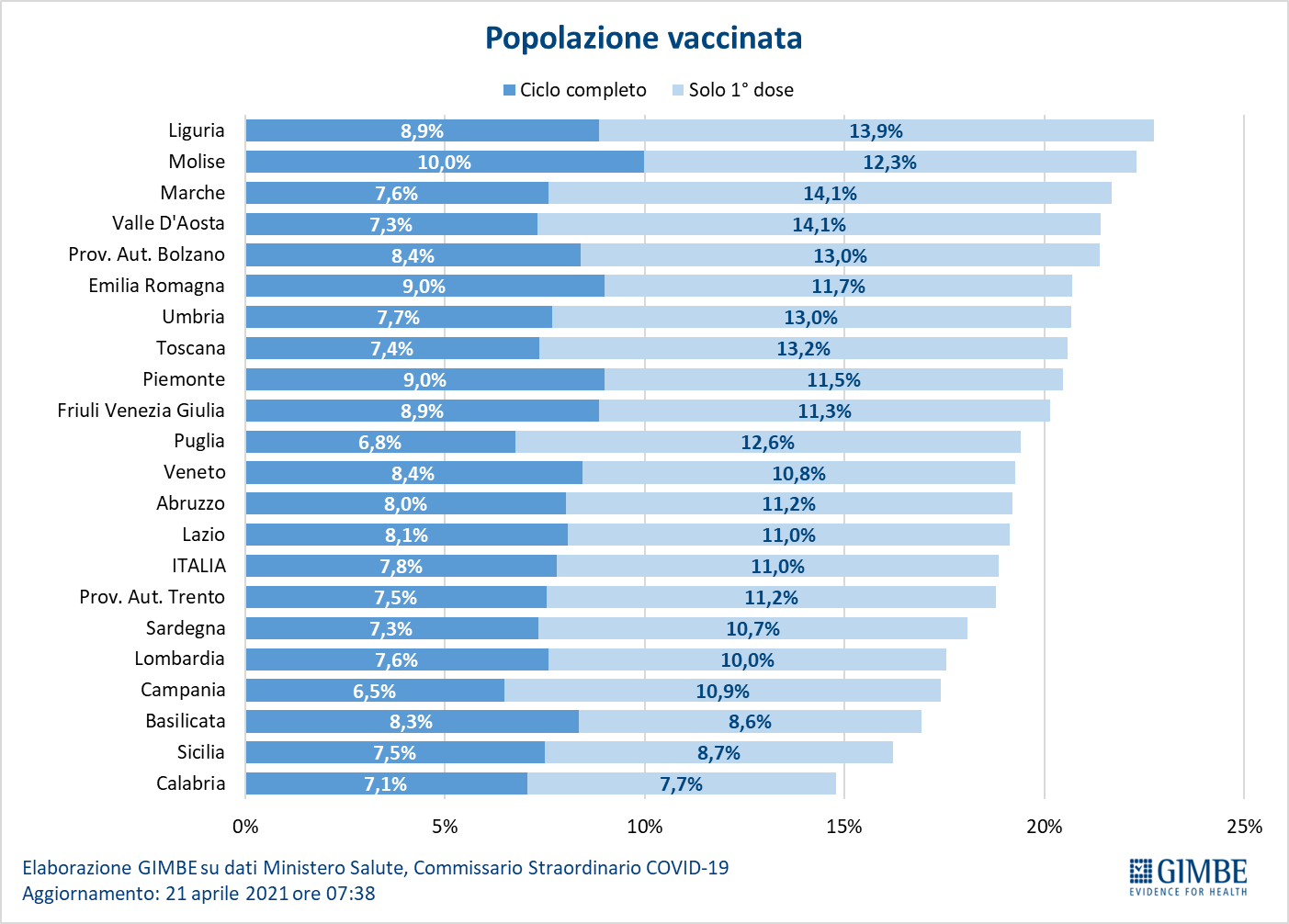
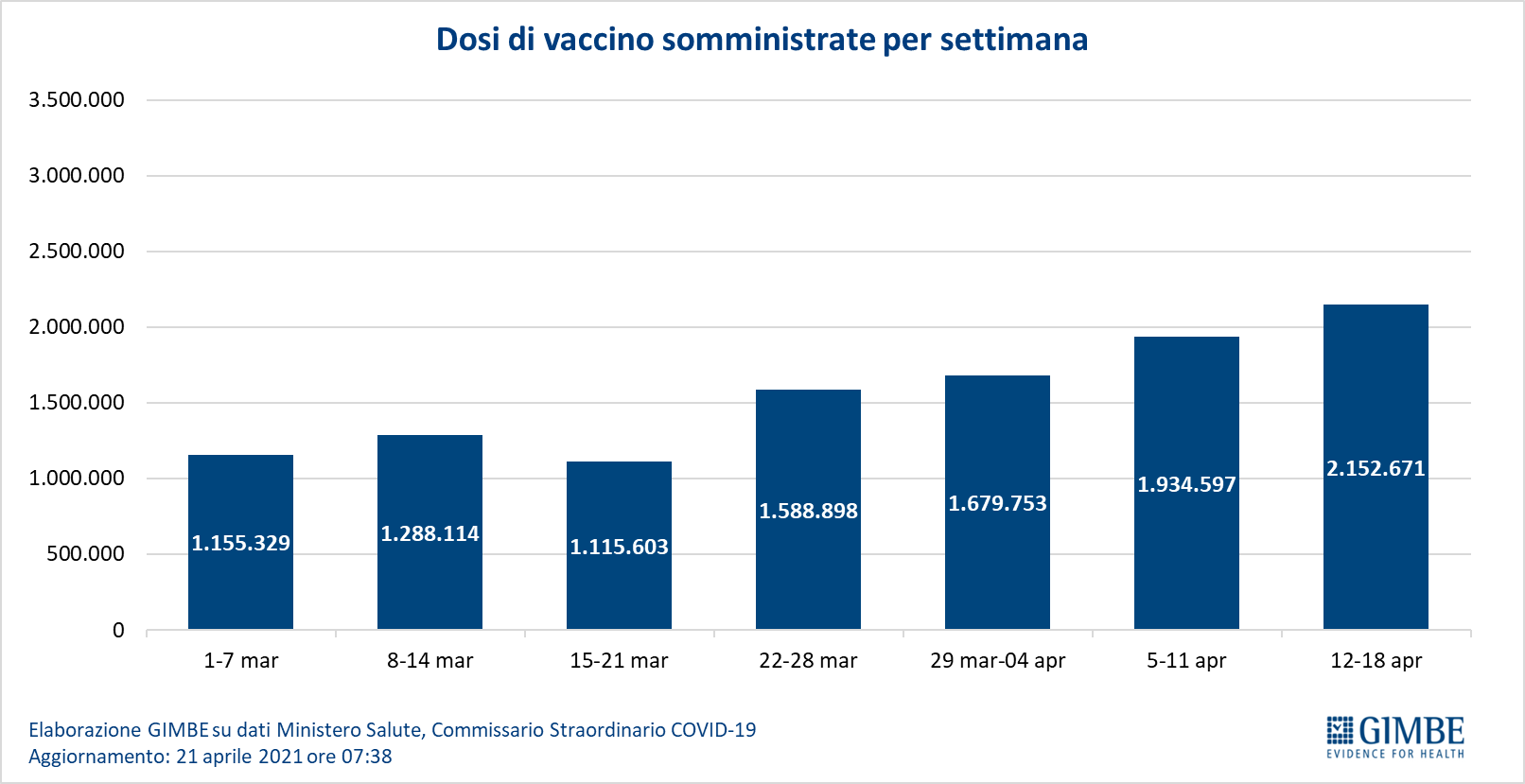
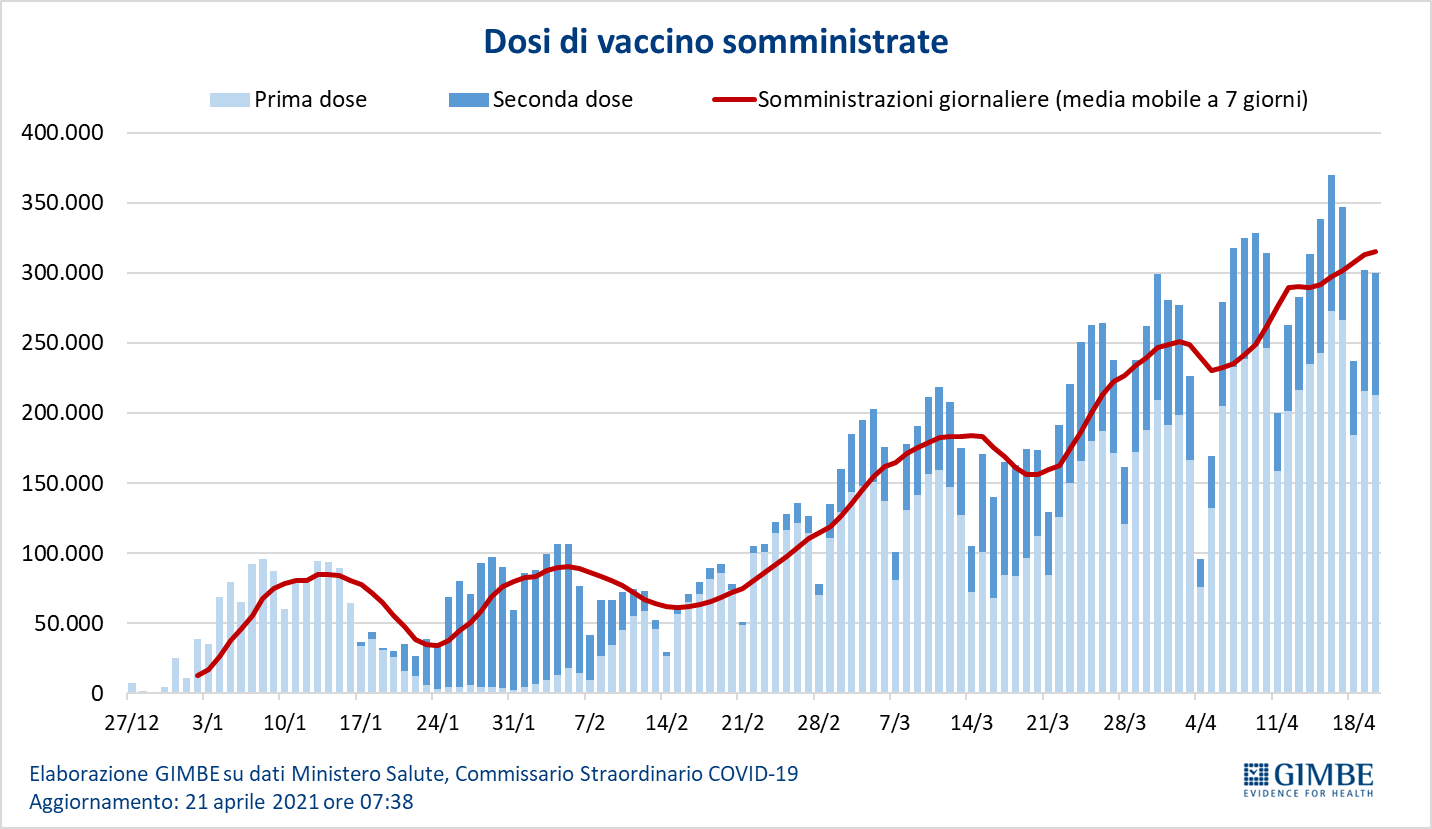
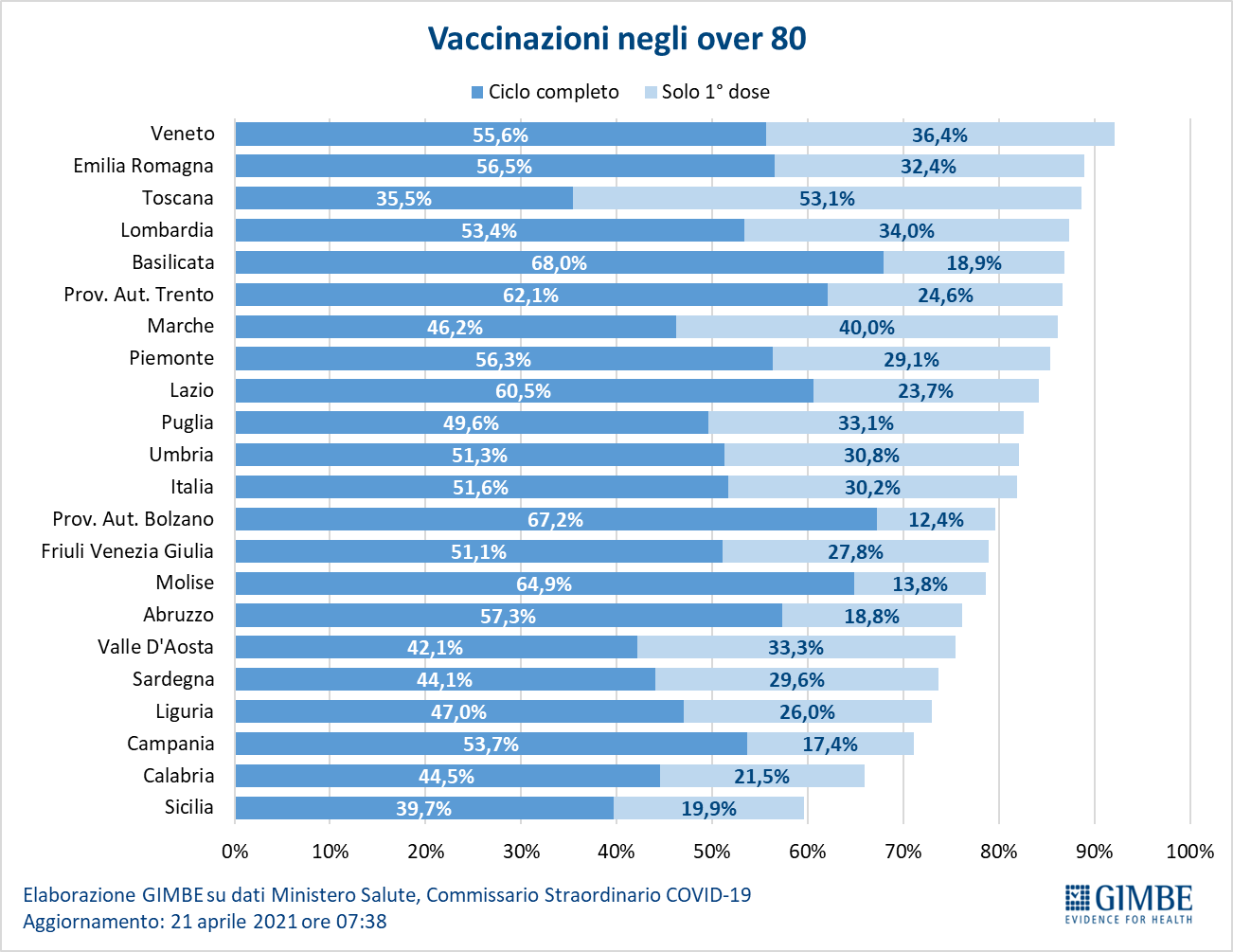
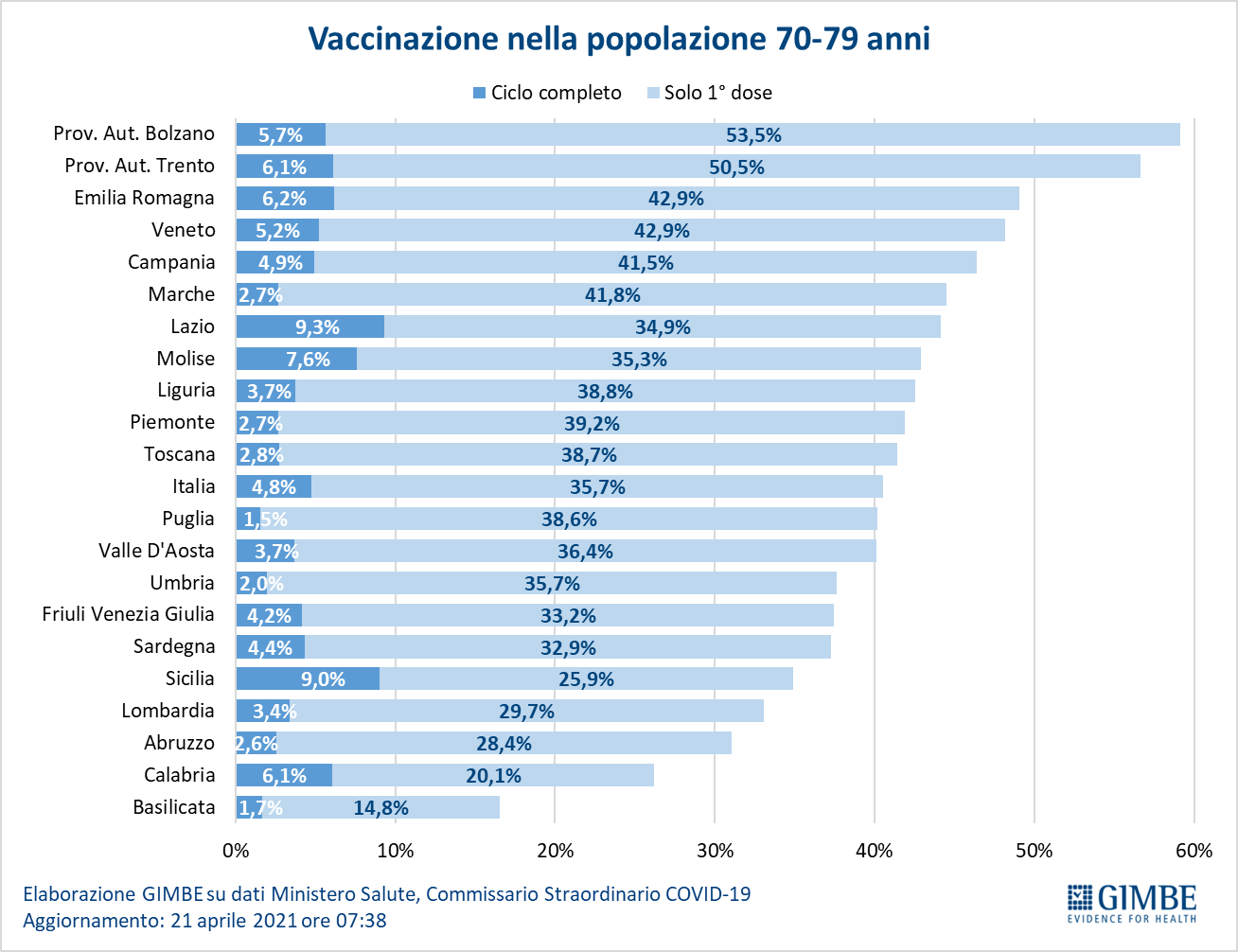
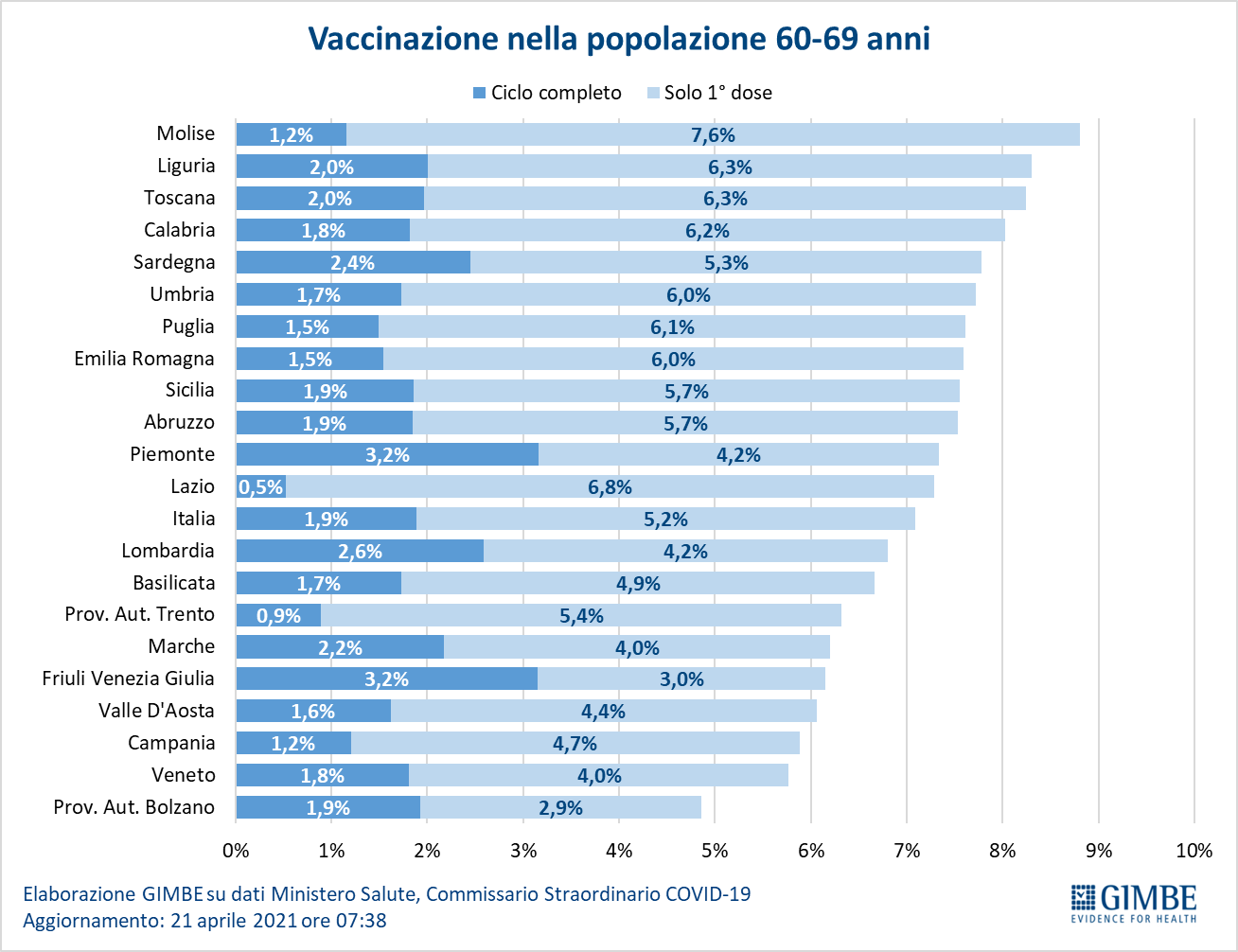
"The Reopening Decree approved yesterday by the Council of Ministers – concludes Cartabellotta – is based on a" reasoned risk ": it is a political decision taken on a tightrope if we look at the pandemic data and vaccination coverage, but at the same time a courageous act of responsibility of the Government to relaunch numerous productive activities and allay social tensions which entrusts citizens with a great responsibility. Clearly, if the gradual reopening will be interpreted as a “free all”, a new surge in infections risks compromising the summer season ».
In order to guarantee the irreversibility of the reopening, therefore, the GIMBE Foundation urges the Government and the Regions to develop an explicit and shared strategy to stem the likely rise of infections and, above all, a medium-long term plan to exit the pandemic that keeps account, in addition to vaccination coverage, of epidemiological scenarios and critical issues never resolved in 14 months of pandemic (box).
Box. Keypoints for a pandemic exit plan
Dynamics of the pandemic and control of the rise in the contagion curve
- The effects of a red-orange Italy will be visible at least until mid-May: in the coming weeks the new cases will drop further and the pressure on hospitals will be reduced.
- The gradual return to yellow and the reopening of schools will inevitably lead to a resurgence of infections, only partially mitigated by the reduced probability of contagion outdoors due to the increase in temperatures which reduces the aerosol effect.
- It is impossible in a short time to reduce the weekly incidence of new cases below 50 cases per 100,000 inhabitants, the maximum threshold for resuming effective tracing.
- Vaccination of people over 70 and frail will have a significant impact in the coming months on hospitalizations and deaths, but not on the circulation of the virus because the vaccination coverage of the population is still low.
Monitoring strategies
- The system of “color” Regions, valid according to the principle of proportionality of the measures, requires an adequate revision after almost six months of “experimentation” which revealed numerous limitations.
- New national parameters are needed to implement timely local closures and avoid the spread of the infection, thus stemming the need for more extensive and stringent restrictions.
Lack of investments and adjustments
- Testing, Tracing & Treating (TTT): laboratories for processing molecular swabs; tracking systems; app; monitored isolation of positives and their close contacts; USCA.
- Schools: systematic mass screening strategies on a periodic basis; adaptations of air exchange systems, despite the proven aerosol transmission of Sars-CoV-2.
- Local transport: places with a high probability of contagion, especially during peak hours and medium-long distances.
- Smartwork: mentioned in all the measures as a way of working to be preferred where possible, it has never been encouraged through tax relief measures.
- Controls: very intense during the first lockdown, they gradually relaxed.
Other
- Standardize the rules on interregional mobility with those for travel abroad, both to limit return infections and not to damage national tourism.
This is a machine translation from Italian language of a post published on Start Magazine at the URL https://www.startmag.it/sanita/consigli-utili-per-un-piano-di-uscita-dalla-pandemia-report-gimbe/ on Thu, 22 Apr 2021 07:51:01 +0000.
